light VAUXHALL ADAM 2014 Repair Manual
[x] Cancel search | Manufacturer: VAUXHALL, Model Year: 2014, Model line: ADAM, Model: VAUXHALL ADAM 2014Pages: 217, PDF Size: 6.68 MB
Page 168 of 217
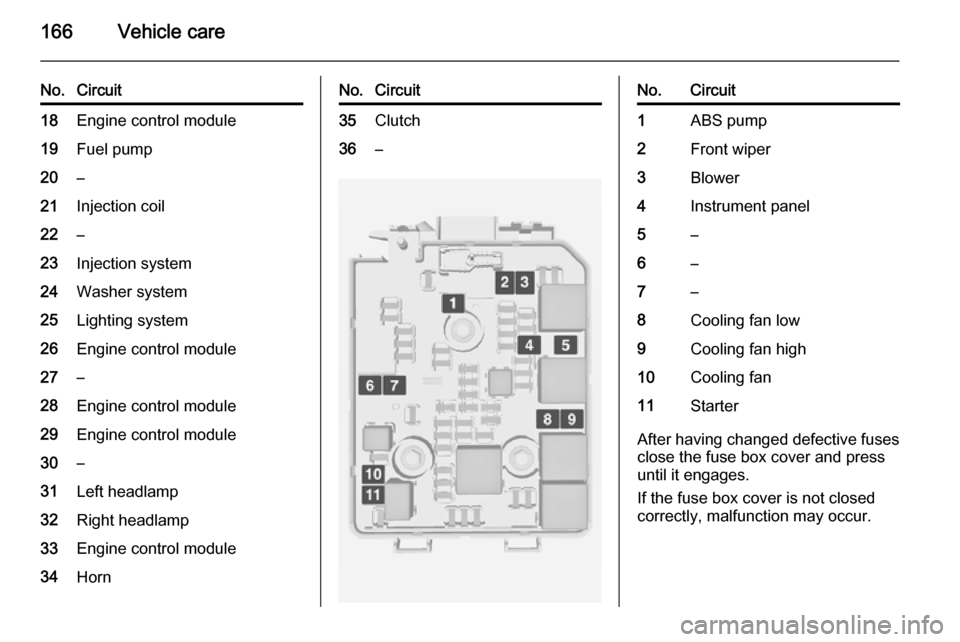
166Vehicle care
No.Circuit18Engine control module19Fuel pump20–21Injection coil22–23Injection system24Washer system25Lighting system26Engine control module27–28Engine control module29Engine control module30–31Left headlamp32Right headlamp33Engine control module34HornNo.Circuit35Clutch36–No.Circuit1ABS pump2Front wiper3Blower4Instrument panel5–6–7–8Cooling fan low9Cooling fan high10Cooling fan11Starter
After having changed defective fuses
close the fuse box cover and press
until it engages.
If the fuse box cover is not closed
correctly, malfunction may occur.
Page 169 of 217
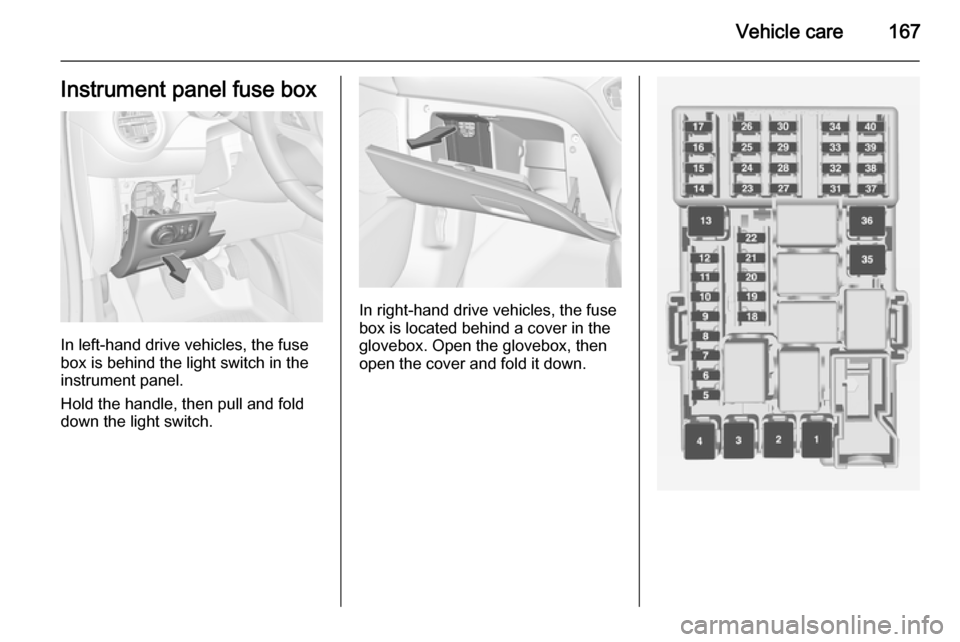
Vehicle care167Instrument panel fuse box
In left-hand drive vehicles, the fuse
box is behind the light switch in the
instrument panel.
Hold the handle, then pull and fold
down the light switch.
In right-hand drive vehicles, the fuse
box is located behind a cover in the
glovebox. Open the glovebox, then
open the cover and fold it down.
Page 170 of 217

168Vehicle care
No.Circuit1–2–3Power windows4Voltage transformer5Body control module 16Body control module 27Body control module 38Body control module 49Body control module 510Body control module 611Body control module 712Body control module 813–14Tailgate15Diagnostic connector16Data link connection17IgnitionNo.Circuit18Air conditioning system19Audio amplifier20Parking assist21Brake switch22Audio system23Display24–25–26Instrument panel27Seat heating, driver28–29–30Instrument panel31Horn32Seat heating, passenger33Heated steering wheel34–No.Circuit35–36–37Rear wiper38Cigarette lighter39–40–
Page 176 of 217
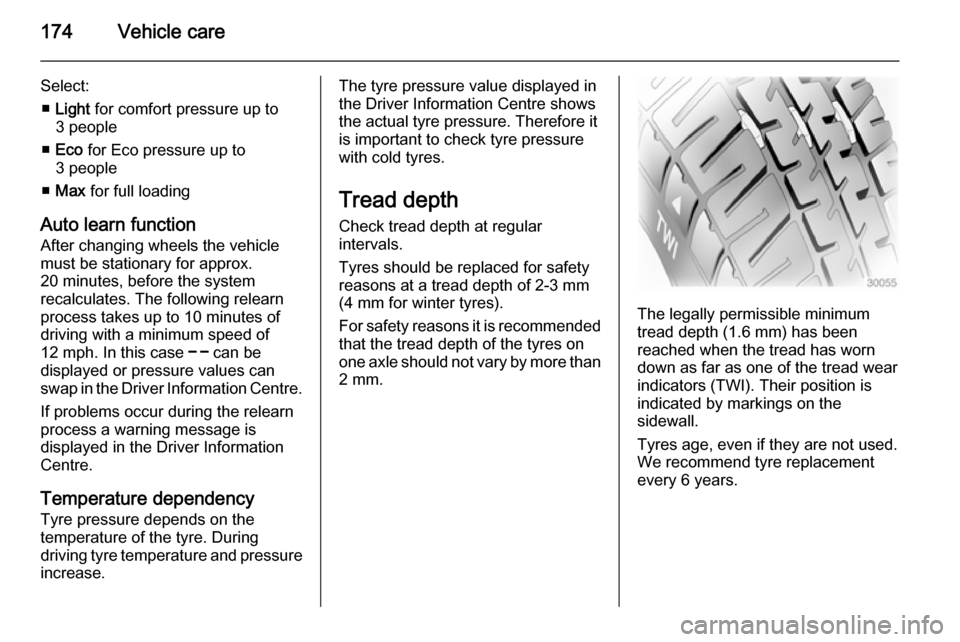
174Vehicle care
Select:■ Light for comfort pressure up to
3 people
■ Eco for Eco pressure up to
3 people
■ Max for full loading
Auto learn function
After changing wheels the vehicle
must be stationary for approx.
20 minutes, before the system
recalculates. The following relearn
process takes up to 10 minutes of
driving with a minimum speed of
12 mph. In this case $ can be
displayed or pressure values can
swap in the Driver Information Centre.
If problems occur during the relearn
process a warning message is
displayed in the Driver Information
Centre.
Temperature dependency Tyre pressure depends on the
temperature of the tyre. During
driving tyre temperature and pressure increase.The tyre pressure value displayed in
the Driver Information Centre shows
the actual tyre pressure. Therefore it
is important to check tyre pressure
with cold tyres.
Tread depth
Check tread depth at regular
intervals.
Tyres should be replaced for safety
reasons at a tread depth of 2-3 mm
(4 mm for winter tyres).
For safety reasons it is recommended
that the tread depth of the tyres on
one axle should not vary by more than
2 mm.
The legally permissible minimum
tread depth (1.6 mm) has been
reached when the tread has worn
down as far as one of the tread wear
indicators (TWI). Their position is
indicated by markings on the
sidewall.
Tyres age, even if they are not used.
We recommend tyre replacement
every 6 years.
Page 180 of 217
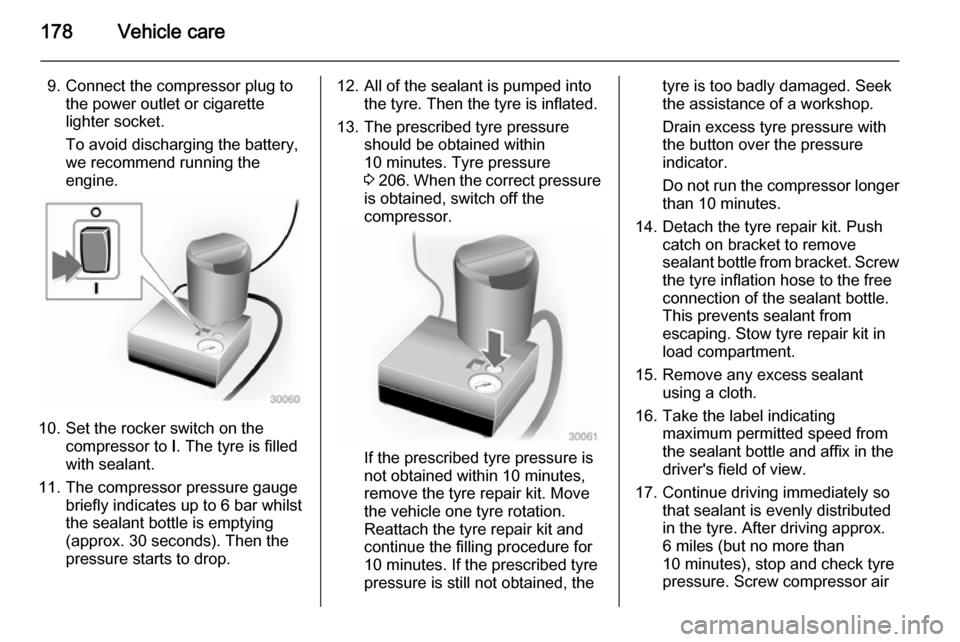
178Vehicle care
9. Connect the compressor plug tothe power outlet or cigarette
lighter socket.
To avoid discharging the battery,
we recommend running the
engine.
10. Set the rocker switch on the compressor to I. The tyre is filled
with sealant.
11. The compressor pressure gauge briefly indicates up to 6 bar whilstthe sealant bottle is emptying
(approx. 30 seconds). Then the
pressure starts to drop.
12. All of the sealant is pumped into the tyre. Then the tyre is inflated.
13. The prescribed tyre pressure should be obtained within
10 minutes. Tyre pressure
3 206 . When the correct pressure
is obtained, switch off the
compressor.
If the prescribed tyre pressure is
not obtained within 10 minutes,
remove the tyre repair kit. Move
the vehicle one tyre rotation.
Reattach the tyre repair kit and
continue the filling procedure for
10 minutes. If the prescribed tyre
pressure is still not obtained, the
tyre is too badly damaged. Seek
the assistance of a workshop.
Drain excess tyre pressure with
the button over the pressure indicator.
Do not run the compressor longer
than 10 minutes.
14. Detach the tyre repair kit. Push catch on bracket to remove
sealant bottle from bracket. Screw the tyre inflation hose to the freeconnection of the sealant bottle.
This prevents sealant from
escaping. Stow tyre repair kit in
load compartment.
15. Remove any excess sealant using a cloth.
16. Take the label indicating maximum permitted speed from
the sealant bottle and affix in the
driver's field of view.
17. Continue driving immediately so that sealant is evenly distributedin the tyre. After driving approx.
6 miles (but no more than
10 minutes), stop and check tyre
pressure. Screw compressor air
Page 190 of 217
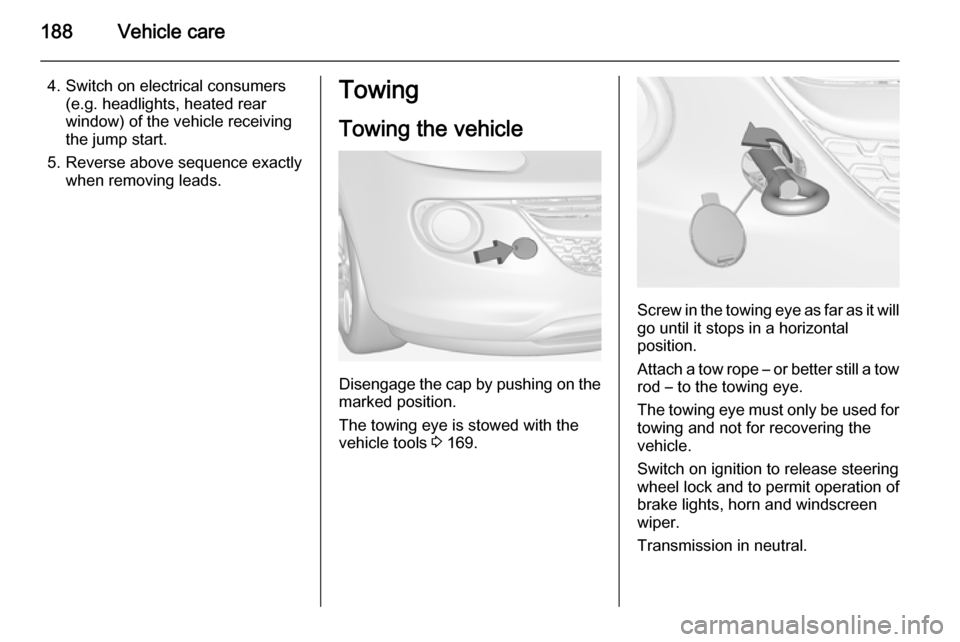
188Vehicle care
4. Switch on electrical consumers(e.g. headlights, heated rear
window) of the vehicle receiving
the jump start.
5. Reverse above sequence exactly when removing leads.Towing
Towing the vehicle
Disengage the cap by pushing on the
marked position.
The towing eye is stowed with the
vehicle tools 3 169.
Screw in the towing eye as far as it will
go until it stops in a horizontal
position.
Attach a tow rope – or better still a tow
rod – to the towing eye.
The towing eye must only be used for
towing and not for recovering the
vehicle.
Switch on ignition to release steering wheel lock and to permit operation of
brake lights, horn and windscreen
wiper.
Transmission in neutral.
Page 193 of 217

Vehicle care191
On vehicles with emblem touchpad:
when cleaning with a high-pressure
jet cleaner ensure a minimum
distance of 30 cm when working
around the tailgate to prevent
unintended unlocking.
Thoroughly rinse and leather-off the
vehicle. Rinse leather frequently. Use
separate leathers for painted and
glass surfaces: remnants of wax on
the windows will impair vision.
Exterior lights Headlight and other light covers are
made of plastic. Do not use any
abrasive or caustic agents, do not use
an ice scraper, and do not clean them dry.
Polishing and waxing
Wax the vehicle regularly (at the
latest when water no longer beads).
Otherwise, the paintwork will dry out.
Polishing is necessary only if the paint
has become dull or if solid deposits
have become attached to it.Paintwork polish with silicone forms a
protective film, making waxing
unnecessary.
Plastic body parts must not be treated with wax or polishing agents.
Windows and windscreen wiper blades
Use a soft lint-free cloth or chamois leather together with window cleaner
and insect remover.
When cleaning the rear window from
inside, always wipe in parallel to the
heating element to prevent damage.
For mechanical removal of ice, use a
sharp-edged ice scraper. Press the
scraper firmly against the glass so
that no dirt can get under it and
scratch the glass.
Clean smearing wiper blades with a
soft cloth and window cleaner.Glass panel
Never clean with solvents or abrasive
agents, fuels, aggressive media (e.g.
paint cleaner, acetone-containing solutions etc.), acidic or highly
alkaline media or abrasive pads. Do
not apply wax or polishing agents to
the glass panel.
Wheels and tyres Do not use high-pressure jet
cleaners.
Clean rims with a pH-neutral wheel
cleaner.
Rims are painted and can be treated
with the same agents as the body.
Paintwork damageRectify minor paintwork damage with
a touch-up pen before rust forms. Have more extensive damage or rust
areas repaired by a workshop.
Underbody
Some areas of the vehicle underbody
have a PVC undercoating while other critical areas have a durable
protective wax coating.
Page 194 of 217
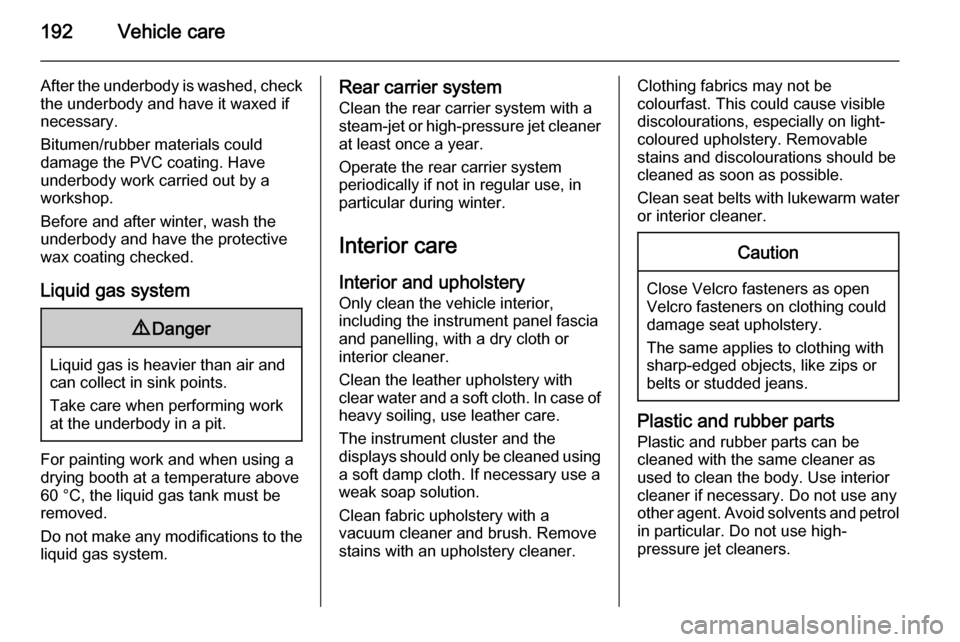
192Vehicle care
After the underbody is washed, checkthe underbody and have it waxed if
necessary.
Bitumen/rubber materials could
damage the PVC coating. Have
underbody work carried out by a
workshop.
Before and after winter, wash the
underbody and have the protective
wax coating checked.
Liquid gas system9 Danger
Liquid gas is heavier than air and
can collect in sink points.
Take care when performing work
at the underbody in a pit.
For painting work and when using a
drying booth at a temperature above
60 °C, the liquid gas tank must be
removed.
Do not make any modifications to the
liquid gas system.
Rear carrier system
Clean the rear carrier system with a
steam-jet or high-pressure jet cleaner
at least once a year.
Operate the rear carrier system
periodically if not in regular use, in
particular during winter.
Interior care
Interior and upholstery Only clean the vehicle interior,
including the instrument panel fascia
and panelling, with a dry cloth or
interior cleaner.
Clean the leather upholstery with
clear water and a soft cloth. In case of heavy soiling, use leather care.
The instrument cluster and the
displays should only be cleaned using
a soft damp cloth. If necessary use a
weak soap solution.
Clean fabric upholstery with a
vacuum cleaner and brush. Remove
stains with an upholstery cleaner.Clothing fabrics may not be
colourfast. This could cause visible
discolourations, especially on light- coloured upholstery. Removable
stains and discolourations should be
cleaned as soon as possible.
Clean seat belts with lukewarm water or interior cleaner.Caution
Close Velcro fasteners as open
Velcro fasteners on clothing could damage seat upholstery.
The same applies to clothing with
sharp-edged objects, like zips or
belts or studded jeans.
Plastic and rubber parts
Plastic and rubber parts can be
cleaned with the same cleaner as
used to clean the body. Use interior cleaner if necessary. Do not use any
other agent. Avoid solvents and petrol in particular. Do not use high-
pressure jet cleaners.
Page 212 of 217

210IndexAAccessories and vehicle modifications .......................... 149
Adjustable air vents ...................116
Airbag and belt tensioners ...........82
Airbag deactivation ................42, 82
Airbag system .............................. 37
Air conditioning regular operation ................................ 117
Air conditioning system .............. 110
Air intake .................................... 117
Air vents...................................... 116
Antilock brake system ................ 124
Antilock brake system (ABS) .......83
Anti-theft alarm system ................24
Anti-theft locking system .............. 23
Appearance care ........................190
Ashtrays ....................................... 75
Automatic anti-dazzle ..................27
Automatic light control ...............102
Automatic locking ........................22
B Battery discharge protection ......108
Battery voltage ............................. 94
Belts.............................................. 34
Bicycle rack .................................. 51
Bonnet ....................................... 151
Brake and clutch fluid .................194Brake and clutch system .............83
Brake assist ............................... 125
Brake fluid .................................. 153
Brakes ............................... 124, 153
Breakdown.................................. 188
Bulb replacement ....................... 156
C Capacities .................................. 205
Car Pass ...................................... 18
Catalytic converter .....................123
Central locking system ................20
Changing tyre and wheel size ...175
Charging system .......................... 82
Child restraint installation locations ................................... 45
Child restraints.............................. 43
Child restraint systems ................43
Cigarette lighter ........................... 75
City mode ................................... 127
Climate control ............................. 15
Climate control systems .............109
Clock ............................................ 73
Code ............................................. 92
Control indicators.......................... 78
Control of the vehicle .................118
Controls ........................................ 68
Convex shape .............................. 25
Coolant and antifreeze ...............194
Cruise control ...................... 85, 129
Page 213 of 217

211
Cupholders .................................. 49
Curtain airbag system .................. 41
D Danger, Warnings and Cautions ...4
Daytime running lights ...............103
Declaration of conformity ............207
Door open .................................... 86
Doors ............................................ 22
Driver assistance systems ..........129
Driver Information Centre .............86
Driving hints ................................ 118
E Electric adjustment ......................25
Electrical system......................... 164
Electronic climate control system 112
Electronic Stability Control.......... 126
Electronic Stability Control and Traction Control system ............84
End-of-life vehicle recovery .......150
Engine compartment fuse box ...165
Engine coolant ........................... 152
Engine coolant temperature gauge ....................................... 77
Engine data ............................... 201
Engine exhaust .......................... 123
Engine identification ...................197
Engine oil ................... 151, 194, 198
Engine oil pressure ......................85Entry lighting .............................. 107
Event data recorders ..................207
Exit lighting ................................ 107
Exterior care .............................. 190
Exterior light ................................. 85
Exterior lighting ....................12, 101
Exterior mirrors ............................. 25
F
First aid ......................................... 65
First aid kit ................................... 65
Fixed air vents ........................... 116
Flex-Fix system ............................ 51
Folding mirrors ............................. 26
Front airbag system .....................40
Front seats.................................... 31
Front storage ................................ 50
Front turn signal lights ...............159
Fuel............................................. 143
Fuel consumption - CO 2-
Emissions ............................... 148
Fuel for liquid gas operation .......143
Fuel for petrol engines ...............143
Fuel gauge ................................... 77 Fuel selector ................................ 77
Fuses ......................................... 164
G Gauges ......................................... 76
Glass panel .................................. 29Glovebox ..................................... 49
Graphic-Info-Display, Colour- Info-Display .............................. 90
H Halogen headlights ....................156
Hand brake ......................... 124, 125
Hazard warning flashers ............103
Headlight flash ........................... 102
Headlight range adjustment ......103
Headlights................................... 101
Headlights when driving abroad 103
Head restraint adjustment .............8
Head restraints ............................ 30
Heated mirrors ............................. 26
Heated rear window ..................... 29
Heated steering wheel .................69
Heating ........................................ 34
Heating and ventilation system . 109
High beam ........................... 85, 102
Hill start assist ........................... 125
Horn ....................................... 13, 69
I
Identification plate .....................196
Ignition switch positions .............119
Immobiliser ............................ 25, 85
Indicators ...................................... 76
Information displays...................... 86
Instrument cluster ........................76